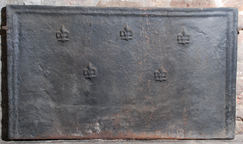-
826
Description: Canted rectangular shape with moulded edging (top and sides) overlain by a length of twisted rope repeated six times; central vertical line formed of twisted rope, crossed with rope upper centre, with rope laid in a diamond pattern around the cross; lower centre, two irregular v-shapes formed of rope, one on each side of the vertical; shield shaped stamp with a fleur de lys repeated twice each side, upper left and right.
Notes: The twin V arrangement may have apotropaic significance and the cross above them having a Christian symbolism; the base board appears to have had a moulded edge, with rope lengths applied over part of the moulding after the board had been pressed into the casting bed; a sketch of this fireback was made by J. Starkie Gardner c.1891 and is in his collection at the Victoria and Albert Museum, Archive of Art and Design (AAD/2014/8).
- Decoration tags:
- rectangular with canted top corners (shape)
- rope over moulding (edging)
- simple stamps
- carved stamps
- heraldic
- apotropaic
- objects
Manufactured: in the late-16th century in the Weald area of England.
Current location: in private hands, Burwash, East Sussex, England.
- Attached to series:
- Miscellaneous stamp firebacks
- Rope design firebacks
-
1070
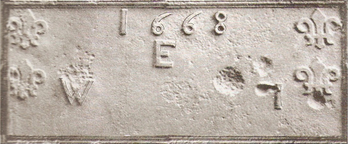 ? x ? mm
? x ? mmDescription: Rectangular; ovolo-moulded edging; two fleurs-de-lys arranged vertically top left and top right; top centre, date; below date, initials WEI in triad.
Notes: Said to have been made by George White, iron founder, of Monmouth. Formerly from Newport, Monmouthshire.
Inscription: 1668 / W E I [triad]
- Decoration tags:
- rectangular (shape)
- ovolo (edging)
- carved stamps
- individual letters
- individual numbers
- heraldic
- text
Manufactured: in 1668 possibly at Tintern Furnace in the Forest of Dean area of Wales.
Current location: National History Museum, St Fagans, Glamorgan, Wales.
Museum number: 25.21 (part of the Welsh National History Museum museum group)
Citation: Kissack, K., 2003, Monmouth and its Buildings (Almeley, Logaston Press).
- Attached to series:
- Date & initials firebacks
-
1111
Description: Arched shape; twisted rope edging (top and sides); top centre, over-pressed Tudor rose stamp on a square block; large diamond-shaped stamp with fleur-de-lys repeated each side below rose, both over-pressed.
Notes: The diamond-shaped stamp has been seen on other firebacks; one of the stamps appears to have been repositioned twice before casting.
- Decoration tags:
- rounded arched (shape)
- rope (edging)
- simple stamps
- carved stamps
- heraldic
Manufactured: in the mid- to late-16th century in the Weald area of England.
Current location: in private hands, Crowborough, East Sussex, England.
- Attached to series:
- Large diamond fleur series
-
45
Description: Rectangular; ovolo-moulded, gadrooned edging (top and sides); a vertical spindle or chair leg surmounted by a fleur-de-lys arranged three times; the date split by the middle fleur-de-lys.
Notes: The fleur-de-lys is separately stamped from the spindle, and the same spindle is seen on another fireback of the same date.
Inscription: 1641
- Decoration tags:
- rectangular (shape)
- gadrooned (edging)
- simple stamps
- carved stamps
- individual numbers
- heraldic
- text
- objects
Manufactured: in 1641 possibly at Cuckfield Furnace in the Weald area of England.
Current location: in private hands, Cuckfield, West Sussex, England.
- Attached to series:
- Spindle series
- Spindle/distaff firebacks
-
922
Description: Rectangular; no edging; arrangement of eight fleur de lys stamps formed of, at top centre, four in a cross shape, with two in line on each side; on each side of the cross arrangement is a naked standing putto stamp.
Notes: The putti are an unusual addition to what is a quite crudely decorated fireback
- Decoration tags:
- rectangular (shape)
- none (edging)
- carved stamps
- heraldic
- humans
Manufactured: in the late-16th century in the Weald area of England.
Current location: in private hands, Heathfield, East Sussex, England.
- Attached to series:
- Figurine firebacks
-
192
Description: Rectangular; twisted rope edging (top and sides); irregular arrangement of four stamps in three rows: face mask with ?crown and ruff (3), flower head with four petals and leaflets (4), fleur de lys (5), and profile of a head with 'Roman' crest (2); initials replace stamps in top corners.
Notes: A larger variant, undated and with other initials but the same four stamps, is also known.
Inscription: TBI I•A•1•6•1•8 / TA S
- Decoration tags:
- rectangular (shape)
- rope (edging)
- carved stamps
- individual letters
- individual numbers
- heraldic
- text
- humans
- plants
Manufactured: in 1618 possibly in the Weald area of England.
Current location: Godolphin House, Helston, Cornwall, England.
Museum number: 169481 (part of the National Trust museum group)
- Attached to series:
- Primitive stamp series
-
368
Description: Canted rectangle; twisted rope edging (top and sides); Tudor royal shield within a Garter, supported by lion and dragon stamps, a crown above, between separate ‘E’ and ‘R’ stamps; fleur de lys stamp irregularly repeated four times below right and to left of lion.
Notes: The shield, garter and crown stamps appear on many firebacks, usually with left-facing lion and greyhound supporters; the presence of the shield and crown indicate the fireback is derived from the same source; the supporter stamps, which are over-pressed, are clearly derived from blocks intended to represent standing models. Formerly at Kirby Frith Hall, Leicestershire. Illustration from Schubert, 1957, pl. 7.
Inscription: HONE SOYT qVEY MAL Y PENSE
Arms: Tudor royal - Edward VI or Elizabeth I
- Decoration tags:
- rectangular with canted top corners (shape)
- rope (edging)
- carved stamps
- individual letters
- heraldic
- armorial
- royal
- text
Manufactured: in the mid- to late-16th century possibly at Pounsley Furnace, Framfield in the Weald area of England.
Current location: Newarke Houses, Leicester, Leicestershire, England.
Museum number: H.101.1930.0 (part of the Leicester City Museums museum group)
-
683
Description: Rectangular; twisted rope edging (top and sides); top left and right, Tudor rose surmounted by a crown (separate stamps); right of centre, irregular pentagram formed of a repeated length of twisted rope enclosing a Tudor rose; on either side of top point of pentagram, a triple-loop stamp irregularly spaced.
Notes: The pentagram has both Christian and occult symbolism. The fleur and the rose and crown have been seen on another fireback.
Copies of this fireback are known.
- Decoration tags:
- rectangular (shape)
- rope (edging)
- simple stamps
- carved stamps
- heraldic
- apotropaic
- objects
Manufactured: in the late-16th century possibly in the Weald area of England.
Current location: in private hands, Sevenoaks, Kent, England.
- Attached to series:
- Rope design firebacks
- Looped fleur series
-
830
Description: Rectangular; stepped fillet moulded edging (top and sides); small fleur-de-lys stamp repeated five times, three centred across the top, two centred across the middle.
Notes: The fleur-de-lys stamp appears to have been constructed using wire.
- Decoration tags:
- rectangular (shape)
- stepped fillet (edging)
- carved stamps
- heraldic
- objects
Manufactured: in the mid- to late-16th century in the Weald area of England.
Current location: in private hands, Iford, East Sussex, England.
- Attached to series:
- Miscellaneous stamp firebacks
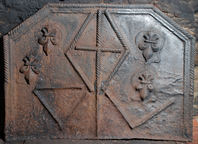
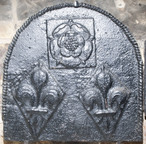

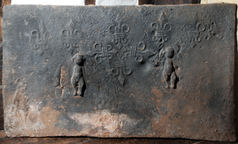
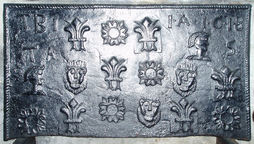
 01.jpg)

